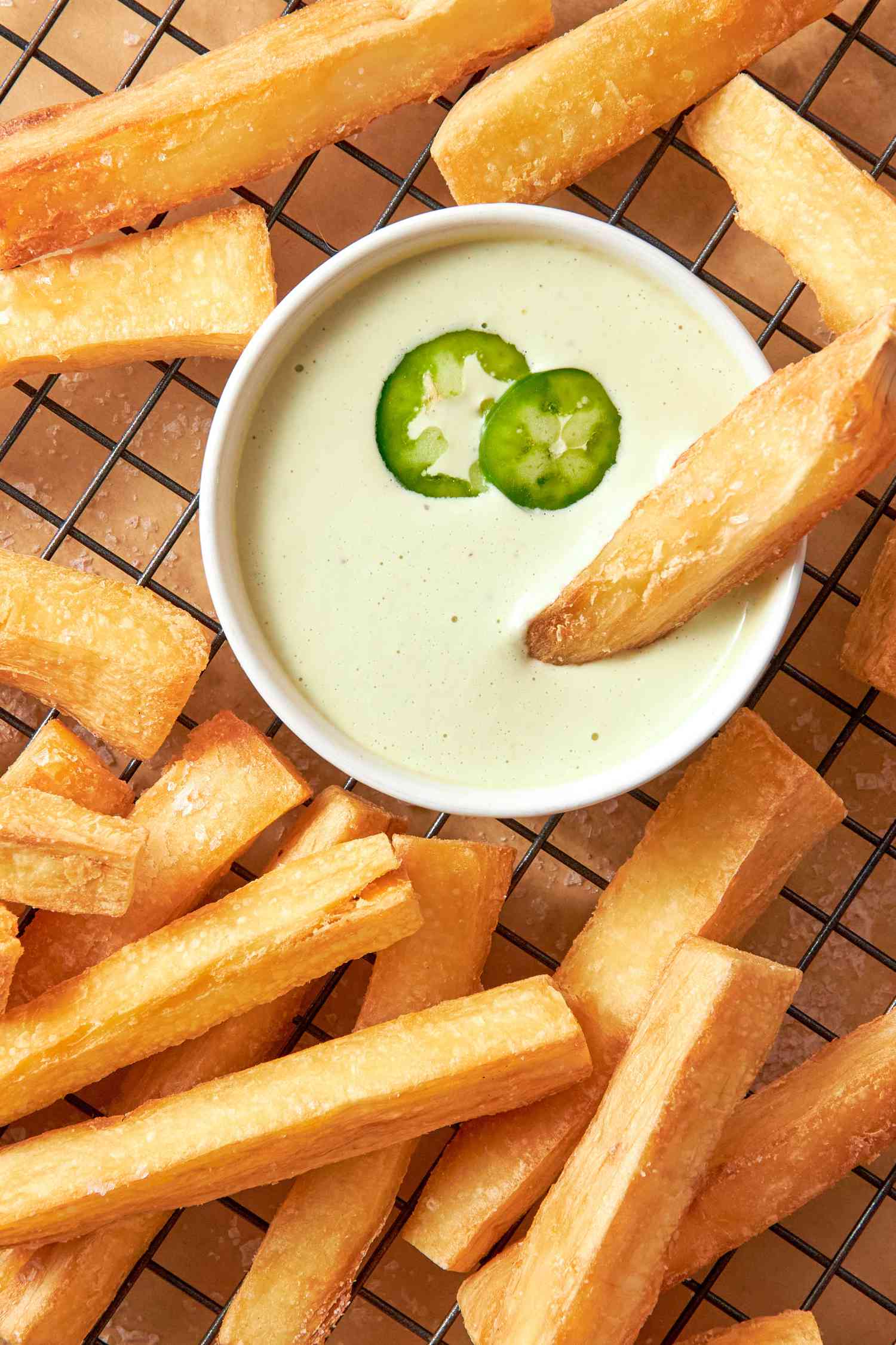If you like french fries, there’s a good chance you’ll love yuca fries. Like potatoes, the starchy consistency of yuca makes it ideal for frying. You can enjoy them any way you would french fries—as a side dish, appetizer, or simply as a snack. They’re delicious seasoned simply with salt, but adding a good dipping sauce or tangy pickled onions makes them especially memorable.
Yuca is consumed in many places around the world, but yuca fries are especially popular in Latin and Caribbean countries. This recipe is inspired by the yuca fries I had in Cuba (and couldn’t get enough of!).
Simply Recipes / Ciara Kehoe
How to Make Yuca Fries
To achieve a perfectly crunchy exterior while maintaining a fluffy inside, the yuca is boiled until tender before frying. After boiling, they are fried until crisp and seasoned with salt. They can also be made in an air fryer, though they won’t have quite the same crunch as with deep-fried yuca fries.
What Is Yuca?
Yuca, also known as cassava or manioc, is a woody shrub with a starchy, tuberous root. (Not to be confused with yucca, an ornamental plant in the agave family.) Because the root is the most utilized part of the plant, many people refer to the ingredient simply as “yuca” though you may see “yuca root” used as well for clarity.
The root is long and tapered, with commercial varieties usually measuring 2 to 4 inches in diameter and 6 to 12 inches long. It has firm white flesh that is covered by a rough brown outer peel that must be removed. The flesh turns pale yellow when cooked and has a starchy texture that is similar to potatoes or yams. It has a mild, subtly sweet, and slightly nutty taste that lends itself to many preparations.
Originating in South America, yuca is now cultivated predominantly in Nigeria and is the third-largest source of carbohydrates in the tropics. It’s enjoyed around the world in many forms—boiled, mashed, fried, roasted, added to soups, and more. In Jamaica, where my family is from, we grate and press cassava to make a flatbread called bammy.
Tip
No matter the preparation, it’s important to never eat yuca raw. Raw yuca contains cyanide, but when peeled and cooked properly, the toxins are removed making it safe to consume.
Simply Recipes / Ciara Kehoe
How to Buy and Store Yuca
You’ll find fresh yuca in the produce section of the supermarket, especially those specializing in Latin and Caribbean ingredients. Frozen yuca is also sometimes available, already peeled and cut.
When shopping for fresh yuca, you’ll notice that the long brown root is covered in wax. You want to look for pieces that are firm and completely free of soft spots. Ideally, the ends will be cut so you can see that the flesh is snowy white without any black spots or discoloration. It should also be virtually odorless, with only a fresh clean smell.
Yuca has a shorter shelf life than you might think. Unpeeled, it should be stored in a cool, dry place like a pantry and will last up to a week. That said, it freezes very well. When peeled and cut into chunks, it can be frozen for months.
How to Peel and Prep Yuca
If you happen to find frozen yuca at the supermarket, the job of removing the root’s fibrous peel will be done for you. If you’ve purchased it fresh, be sure to account for this step.
First, cut off each end of the root using a sharp knife. Cut the length of the yuca crosswise into manageable pieces—about 4 inches long (this will also be the length of your fries). To remove the outer waxy bark and inner peel, don’t reach for a vegetable peeler. Instead, cut a shallow slit down the length of the yuca. Wedge a butter knife or your fingers under the peel and lift those layers to remove it from the flesh of the yuca.
If this proves too difficult, you can also stand the yuca piece up on its end and use a sharp knife to slice vertically along the edge, as you would when peeling a pineapple. If there are a few brown spots, simply cut them out. If you see lines or discoloration spread throughout the root, don’t use it.
Inside the yuca runs a fibrous thread down the center. I find it’s easiest to remove this core after boiling but you can also remove it while the yuca is raw. If so, quarter the peeled pieces of yuca lengthwise and use your knife to cut out the core.
Simply Recipes / Ciara Kehoe
Yuca Fries Variations
Classic yuca fries are seasoned with just salt, but you can customize this recipe in any number of ways. Garlic or other aromatics could be added to the boiling water to flavor the yuca during that initial cooking.
You could also season your cooked yuca fries with fresh herbs or a spice blend of your choosing. Even a simple combo of salt, pepper, onion powder, garlic powder, and paprika would be delicious.
Choosing a Dip
Another opportunity for customization is the dip. If you’d like something bright and herbaceous, go for a chimichurri, mojito sauce, or your favorite salsa. For a creamy accompaniment, a cheese sauce, guacamole, or mayo-based dip (like we’re using here) all complement the crispy yuca well.
If you’re not necessarily a “dip person,” tangy pickled red onions make a delicious topping.
